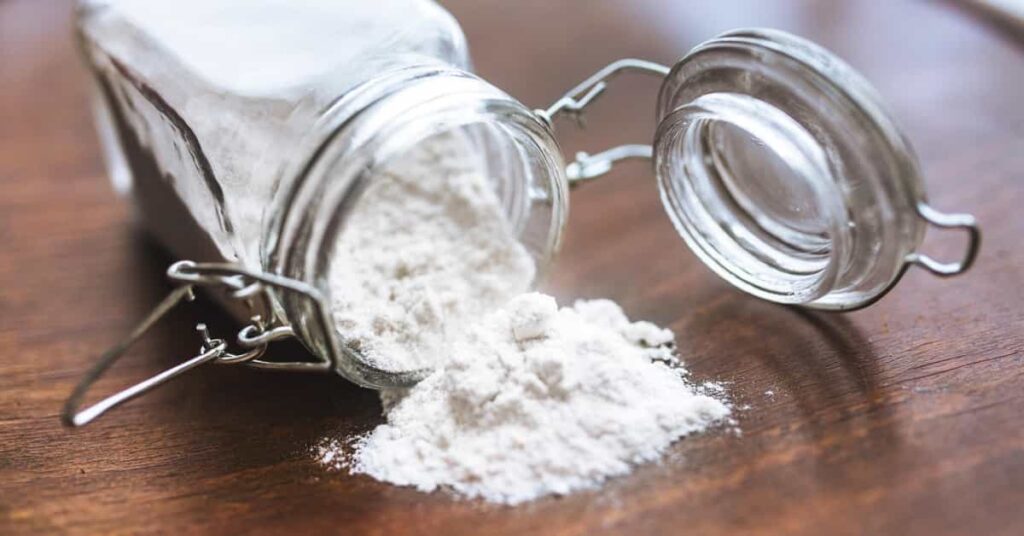Table of Contents
Introduction
Xanthan gum is a chain of sugar structure blocks made by fermenting simple sugars (monosaccharides) with a distinct type of bacteria. It is occasionally used to make medicine. It is used for diabetes, dry eye, constipation, and many other conditions, but there is little scientific proof to help with most of these uses. In manufacturing, this gum is utilized as a thickening and stabilizing agent in foods, medicines, and toothpastes.
Xanthan gum swells in the intestine, promoting peristalsis and moving stool through the intestine. It also slows the absorption of sugar from the digestive tract.

Xanthan gum
Xanthan gum is a food additive utilized as a stabilizer or thickener. While it has health advantages, swallowing too much may induce digestive issues.
Surprisingly, wallpaper glue and salad sauce have something in common. It’s gum, a food additive that you’ve probably never heard of but likely swallow several times per week.
Given that it’s found in numerous industrial products and has been related to respiratory and digestive issues, many individuals are concerned about its safety.
But the FDA (Food and Drug Administration) believes this gum is safe for use as a food additive. Moreover, its popularity as a supplement and familiar ingredient in gluten-free products is growing.
It may even have health advantages, such as lowering cholesterol and blood sugar levels.
Xanthan gum uses
It serves two immediate objectives:
- As a thickening agent, it is added to toothpaste and additional products to keep a uniform consistency. It is even utilized in industry, for example, to thicken drilling oil.
- As an emulsifier, its capacity to bind moisture may help prevent products from separating. For this reason, it is an element in some oil-based salad dressings and cosmetics.

Xanthan Gum Benefits
It is a widely used polysaccharide (sugar-based polymer) understood for its unique functioning properties, which translate into several practical and health-related advantages:
1. Superior Food Functionality
- Outstanding Thickening Agent: It is highly effective at thickening liquids, even in small amounts. In salad dressings, sauces, and soups, it is critical to provide body and texture.
- Effective Stabilizer and Emulsifier: It prevents oil and water from separating (emulsification) and suspends solid particles in the liquid (stabilization). This is vital for maintaining ingredient consistency in products like ice cream, dressings, and lotions.
- Gluten-Free Baking Structure: In gluten-free baking, xanthan gum is essential. It replaces the elasticity and stickiness that gluten supplies, preventing baked goods from grinding and giving them softness, structure, and chewiness.
2. Digestive and Blood Sugar Benefits
- Aids Blood Sugar Control: This gum contains soluble fiber. When consumed, it type a thick gel in the digestive tract, delaying the rate of sugar absorption into the bloodstream. This reduces sudden blood sugar spikes, helping individuals with diabetes.
- Boosts Digestive Regularity: As a non-digestible fiber, it adds bulk to stool and improves water retention in the intestines, helping promote regular bowel movements and control constipation.
- Supports Satiety: The gelling action contributes to a feeling of fullness, which can aid in weight management by lowering overall food intake.
3. Therapeutic and Other Uses
- Swallowing Aid (Dysphagia): Xanthan gum is widely utilized to thicken liquids for patients with dysphagia (problem swallowing) to prevent aspiration (the entry of liquid into the lungs). It permits liquids to be thickened without significantly altering their taste.
- Saliva Substitute: It is utilized in specific pharmaceutical formulations as a binding agent or as an element in products that imitate natural saliva to alleviate dry mouth.
- Cholesterol Reduction (Potential): Due to its soluble fiber content, high consumption of xanthan gum has been shown in some analyses to bind to bile acids in the gut, potentially leading to a slight reduction in total and LDL (low-density lipoprotein) (“bad”) cholesterol levels.

Xanthan Gum Side Effects
It is a typical food additive used as a thickener, emulsifier, and stabilizer, primarily in gluten-free baking and processed foods. It is typically considered safe when ingested at levels usually found in food.
Nevertheless, consuming enormous amounts or having specific medical requirements can lead to possible side effects:
1. Gastrointestinal Issues
The most common side effects are linked to its high fiber content and its gelling properties:
- Bloating and Gas: Since xanthan gum is a non-digestible soluble fiber, it ferments in the large intestine. This fermentation procedure can produce gas, leading to bloating, abdominal distress, and flatulence, particularly when ingested in high doses.
- Diarrhea or Loose Stools: Consuming large amounts can have a laxative effect, improving the water content of the stool and speeding up bowel transit time, which can cause diarrhea.
- Intestinal Blockage (Rare): In excessive doses or without adequate fluid intake, the gelling effects of xanthan gum can contribute to a mass in the intestine, though this is very rare.
2. Allergic Reactions
- Corn/Wheat Allergies: It is produced by fermenting simple sugars, often derived from corn, wheat, or soy. While the outcome is highly purified and normally safe even for individuals with gluten or soy allergies, those with extreme sensitivities to the source materials may still experience an allergic reaction.
3. Respiratory Concerns (Occupational Hazard)
- Lung and Respiratory Irritation: This is not a concern for food consumers but is an occupational hazard for workers who handle the fine powder form in industrial settings. Inhaling the dust can cause nose and throat irritation and flu-like symptoms.
4. Risk for Infants (Severe Warning)
- Necrotizing Enterocolitis (NEC) in Premature Infants: Xanthan gum is highly dangerous for premature infants. A thickening product that included xanthan gum (called “SimplyThick”) was linked to cases of Necrotizing Enterocolitis (NEC), a severe intestinal disease, in premature infants. Due to this risk, the FDA and other health organizations strongly warn against using products containing xanthan gum to thicken breast milk or formula for premature infants.
Xanthan gum powder
Xanthan gum powder is the commercially available form of xanthan gum, a polysaccharide (a long chain of sugar molecules) produced through the microbial fermentation of simple sugars by the Xanthomonas campestris bacterium. After fermentation, the sticky residue is dried and ground into a fine, white or yellowish powder.
Key Characteristics and Uses:
- Potent Thickener: Even at extremely low levels (as little as 0.1%), xanthan gum powder creates a highly viscous, gel-like solution. This makes it a powerhouse thickening agent in culinary and industrial applications.
- Stabilizer and Emulsifier: It is valued for its ability to stabilize mixtures, preventing solids from settling (e.g., in juice or dressings) and acting as an emulsifier to keep oil and water phases from separating (e.g., in salad dressings and ice cream).
- Gluten Replacement: It is a vital ingredient in gluten-free baking. Since gluten provides elasticity and structure, xanthan gum powder is added to flours (like rice flour or almond flour) to mimic the chewiness, stretch, and structure that gluten would usually provide, preventing baked goods from crumbling.
- Health Profile: The powder is non-digestible, acting as a soluble fiber. When consumed, it forms a gel in the digestive tract, which is responsible for its health benefits, such as slowing down sugar absorption and promoting regular bowel movements.
Due to its high efficacy, xanthan gum powder is a common ingredient in modern packaged foods, cosmetics, and pharmaceuticals.
Xanthan gum substitute
A handful of choices to xanthan gum can thicken food and guarantee an even texture:
- Psyllium fiber works very well as a binding agent and counts as dietary fiber.
- Chia seeds soak water, producing a more gelatinous food.
- Gelatin helps moisturize food and keeps a consistent texture.
- Agar is a vegan alternative to some additional thickeners, such as gelatin.
- Ground flax seeds can bind with food and help create a more even texture.
- Potato, cornstarch, or arrowroot can also enhance the texture, thickness, and different belongings of both cold and baked foods.
Special Precautions and Warnings
When taken by mouth: It is likely safe in the amounts or quantities found in foods. It is also likely safe when accepted as a medicine in doses up to fifteen grams per day. It may provoke some side effects, for example, intestinal gas and bloating. When applied to the skin, it is likely safe when used appropriately.
Pregnancy and breastfeeding: There isn’t enough trustworthy information to determine whether this gum is safe to use during pregnancy or while breastfeeding. Remain on the safe side and avoid utilizing quantities larger than those normally found in foods.
Nausea, appendicitis, vomiting, hard stools that are hard to expel (fecal embedded), narrowing or stoppage of the intestine, or
un-diagnosed stomach pain: Do not utilize xanthan gum if you have any of these situations. It is a bulk-forming laxative that could be dangerous in these conditions.
Conclusion
Xanthan gum is a food thickener. It is an element in a vast variety of foods and products, including toothpaste. Though it may offer many health benefits, its primary use is to improve the texture of food. This is a polysaccharide, a kind of sugar created by a bacterium named Xanthomonas campestris through fermentation. Xanthomonas campestris infects a vast range of cruciferous plants, such as cabbage, Brussels sprouts, and cauliflower, causing diseases, including examples of black rot and bacterial wilt.
Manufacturers make this gum by extracting bacteria from various plants. The finished product contains no viable bacteria, so there is no chance of xanthan gum inducing infections.




